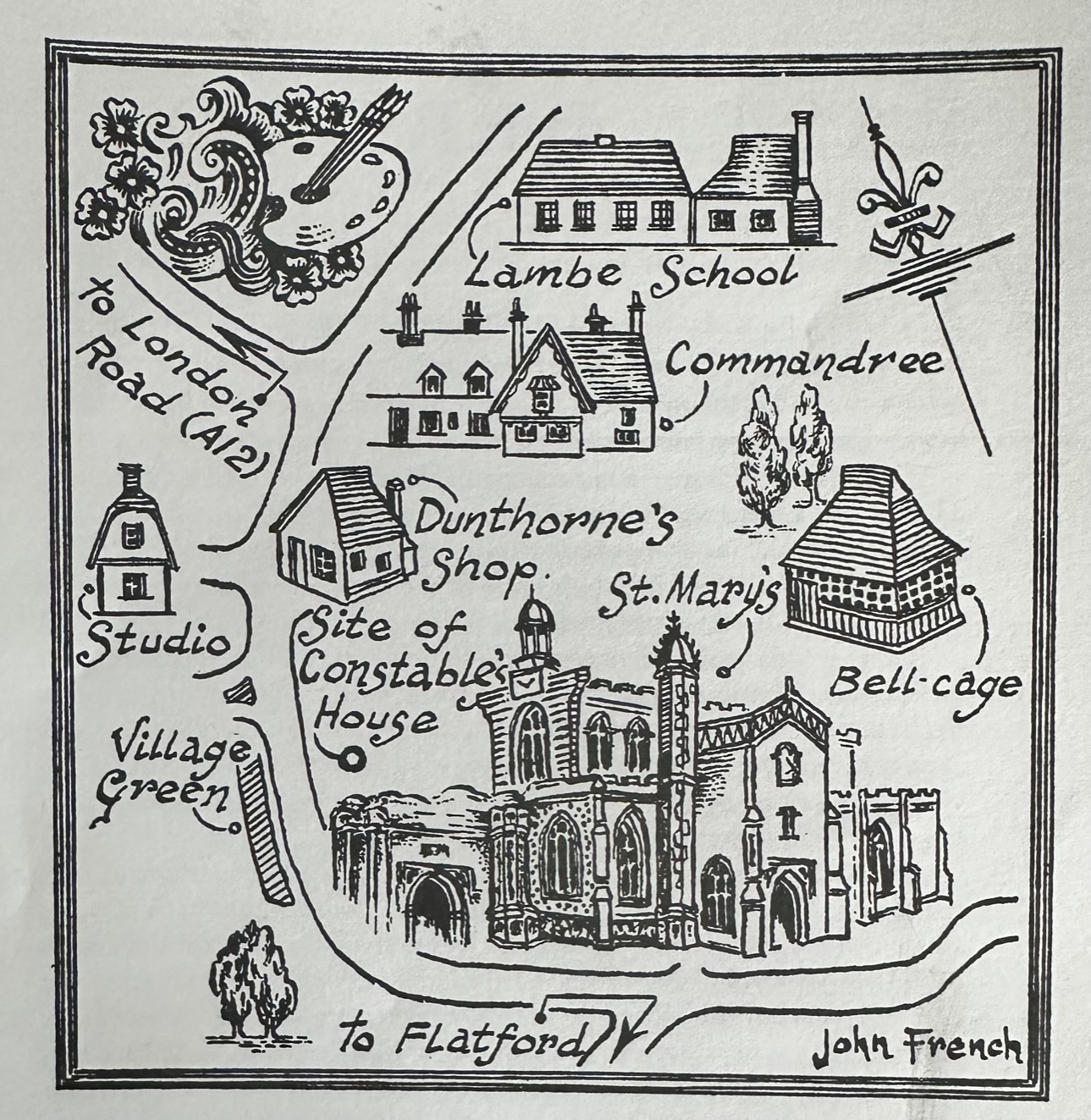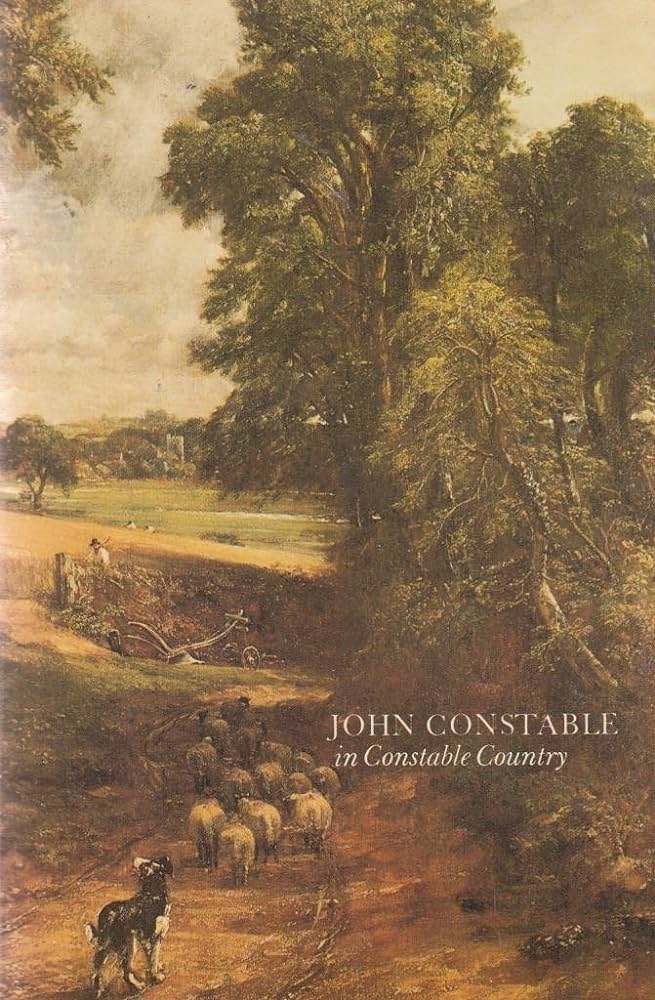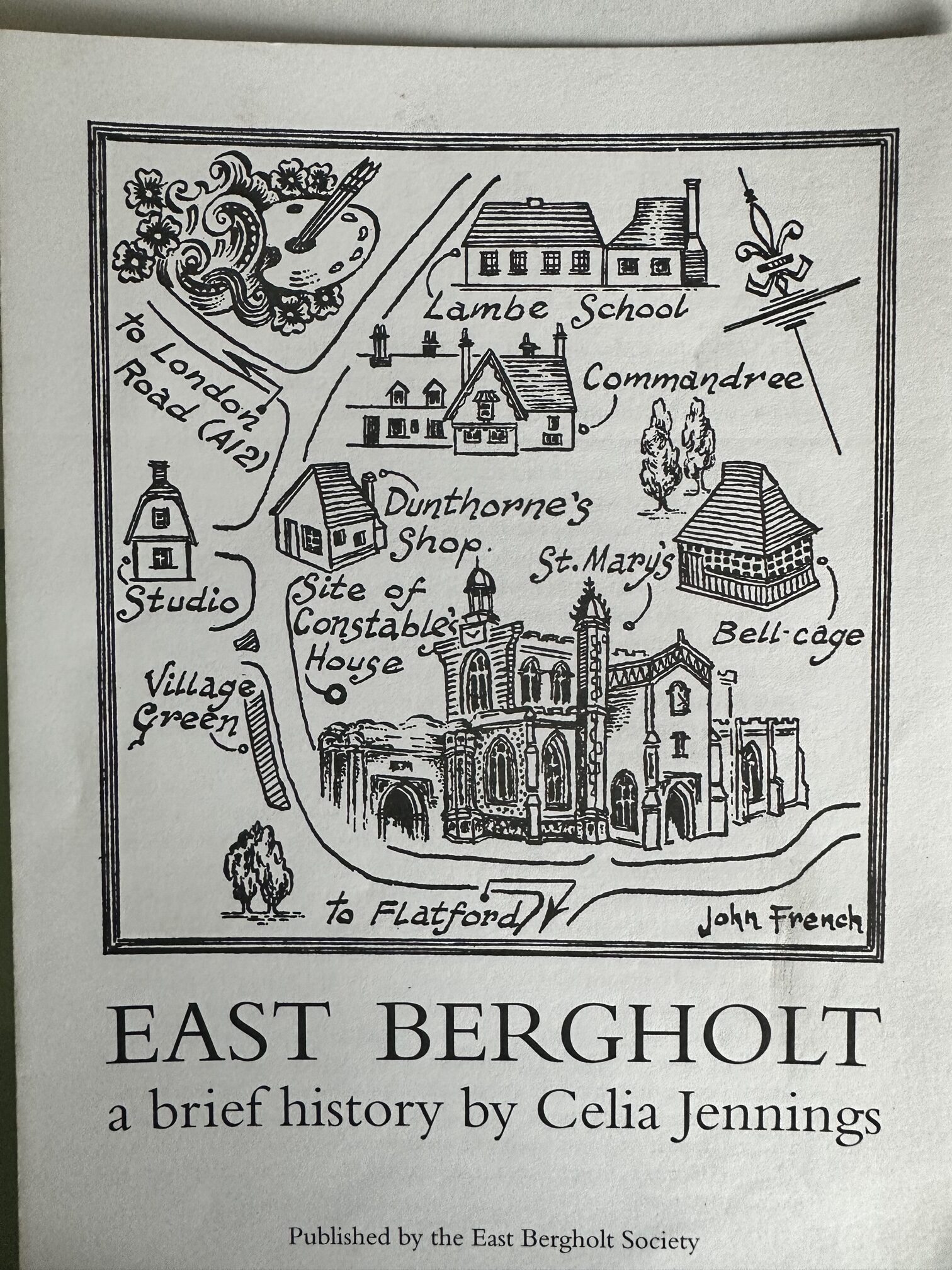A brief History of East Bergholt
Celia Jennings lived with her husband ‘Paul Jennings’ (British Author) at Hill House on Rectory Hill in the 1960’s-1980’s and lead a group of people interested in local history of the village.
She wrote a number of articles for the East Bergholt Society and also published ‘John Constable in Constable country’ in 1977
- 65
- By Celia Jennings Circa1975 East Bergholt Society
Details
East Bergholt
A brief history by Celia Jennings
Published by the East Bergholt Society Circa 1975
In 1734 John Kirby wrote of East Bergholt in ‘The Suffolk Traveller’ The cloth manufacture formally flourished here. It is supposed to have been a market town, but the market is disused the town is greatly reduced, many houses having lately been pulled down’
These few words give a fair indication of the history of East Bergholt. Though the earliest settlement was agricultural, Bergholt rose by the 15th century to be the most important clothing town in the Samford Hundred, but with the decline of the cloth trade in the late 16th century, it reverted to a village primarily concerned with farming.
There is little real evidence of early settlements, though there are signs of Romano-0British occupation to the south of the village, and it seems likely that there was an Anglo-Saxon settlement at Flatford for there was almost certainly a church there in early times. To the north-east of the village on a ridge overlooking Dedham Vale, there is an earth work which is also thought to be Anglo-Saxon.
In Old English, Bergholt means either a ‘wooded hill’ or a birch grove’, the former meaning seems more probable, and even a hundred or so years ago it would have been easy to see the reason for this name, for the centre of the village would have afforded a magnificent view of the Vale. In the late 19th Century the village green was annexed and the hedge and walls of Stour House now prevent one from feeling any sense of height here.
Bergholt was recorded in Domesday as a royal manor. By the 15th Century it had been divided into four: the principle manor being known as OLD HALL, and the lesser as ILLARIES, SPENCERS, and COMMANDERIE or ST JOHNS which Henry II bestowed on the Knights Templars. Of these only the manor house of Old Hall survives, a find house rebuilt in the 18th Century, later rather spoilt by the forbidding additional of the Benedictine Convent. The Splendid house, part of which is knows as Commanderie, does not appear to have been the manor house which , according to William Braziers magnificent map of 1731, was situated on the Manningtree Road.
About the same time as the Spanish Armada it was prohibited by law to export ‘undressed’ or undyed cloth, and since Bergholt had supplied a large proportion of such cloth to be exported from Ipswich there was a disastrous collapse of the cloth industry and the justices of Bergholt claimed that ‘we find the stocks and wealth of the inhabitants greatly decayed’. After this time the market was discontinued and the problem of the poor became acute.
The collapse of the cloth trade has often been blamed for the lack of a complete tower to the handsome church which shows so much early 16th century work. A local legend blames the devil who was supposed to have pulled it down, and Cardinal Wolsey was believed to have promised money, but fell from grace before the building could be completed. There is no direct evidence that Wolsey had any connection with Bergholt and it seems probably that lack of money was the real cause of the work remaining unfinished. The tower was begun in 1525 and though there were still wealthy men in Bergholt after the Reformation they tended to leave money to the poor rather than to church building. By 1537 no more progress had been made for for in that year the will of Robert Spere includes ‘I give to the byldying of the Stepyll of Estbergholt before said XXIi to be payed in a yere when the parishe do bylde the said Stepyll” and in 1541 Thomas Grythe, a wealthy clothier, left a hundred marks for the same purpose. If, as is popularly supposed, the famous bell cage was built in 1531, these bequests may indicate that the cage was intended as temporary accommodation for the bells.
It is hardly surprising that a place that was, in common with most of East Anglia, fairly open to new ideas of the Reformation should have already run into trouble under Mary Tudor. Robert Samuell, a clergyman of East Bergholt, was burnt at the stake in Ipswich in 15555. Disturbances continued and in 1644 the rector, Mr Jones, was declare by the Puritans to be ‘Malignant’ and replaced by someone more pleasing to the inhabitants. Non-conformity was formally established in Bergholt in 1689. The Dissenters ‘Chapel, the first in the district, stood behind the post office and may well be incorporated in the Old Manse.
In 1594 Edwarde Lambe, a benevolent Lawyer and Lord of the Manor of Illaries, endowed a school for the teaching of poor boys. The original school house still stands, refaced in brick with a 19th century addition, but in the interior remains remarkably unchanged.
It is of course the birthplace of John Constable that East Bergholt is best known. He was born in 1776, the son of a prosperous corn merchant who owned considered property in the neighbourhood, including Flatford Mill. The house is which Constable passed his youth was demolished in the 19th Century and only the stable block, the railings and one of the entrance gates remain. The small shop by the gate was occupied by John Dunthorne, a plumber and glazier, who first introduced Constable to painting and was his companion on his early sketching expeditions. Not far away stands the tiny cottage which the painter used as a studio in his early days.
It is still possible to recognise some of the scenes that Constable painted, particularly at Flatford, where Willy Lott’s house looks perhaps more immaculate than it did wen the Haywain was painted. The Lott family-owned various farms in Bergholt and the tombstones of some of them may be seen in the church yard, where also are buried the artists parents, Golding and Ann Constable. On the hill towards Manningtree stand the rectory where Dr Rhudee, the formidable rector of Bergholt lived, and where Constable first met his wife, Rhudds’ granddaughter, then a child of twelve.
In spite of new buildings, the village is still recognisable as the one that Constable knew and loved. A two-mile long road surrounds the great area of common land and heath which even the painters lifetime had begun to be cultivated. There are still quite separate settlements: the village nucleus, Gaston End, Burnet Oak, with the ‘Town House’ on the southwest corner which was bought by the overseers of the poor in 1654 to house paupers, and East End where the manors of Spencers and Illaries lay. A walk round this road will display some interesting examples of architecture (see Looking at East Bergholt also published by The East Bergholt Society) A few of the clotheries’ houses have survived almost unchanged, notably ‘Chaplins’ at Gaston End, while others were ‘improved’ in the 18th century by false fronts of white Suffolk Brick.
Those who wish to know more of the history of the village should read’ East Bergholt in Suffolk’ by T.F. Paterson (privately printed in 1923). John Constables Correspondence Vol 1 (Suffolk Records Society 1962) and Brenda Gamlin’ Old Hall: The story of a Suffolk Manor. William Braziers map of 1731 may be see at the Suffolk Record office in Ipswich.
Celia Jennings
circa.1980
- 65
- By Celia Jennings Circa1975 East Bergholt Society



